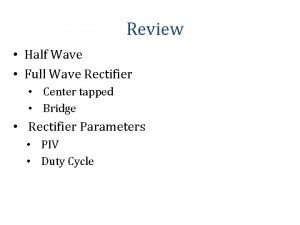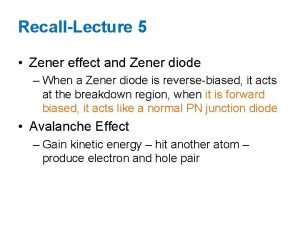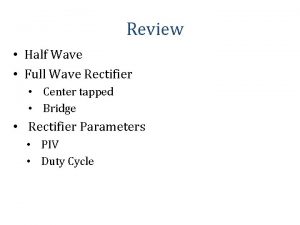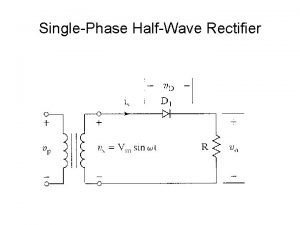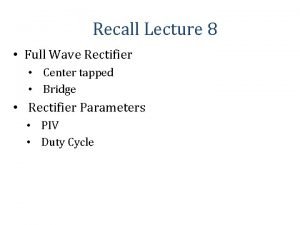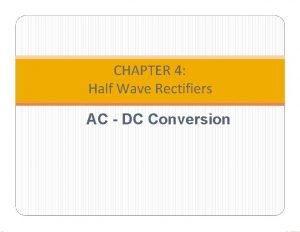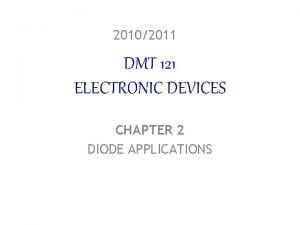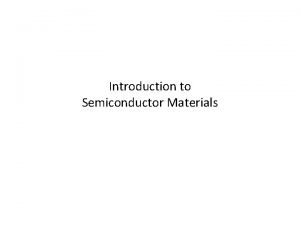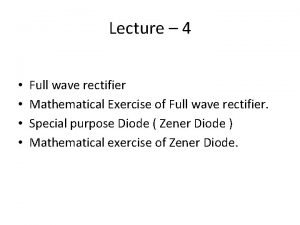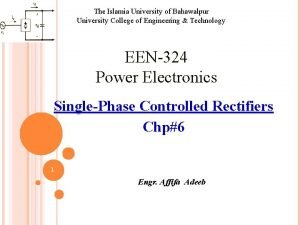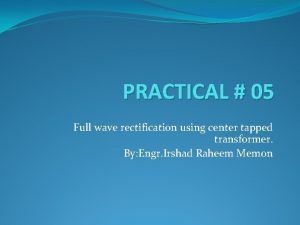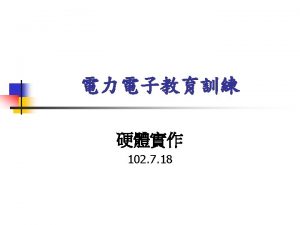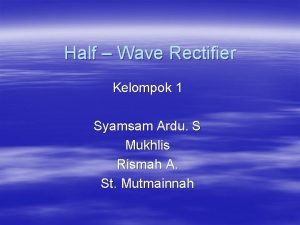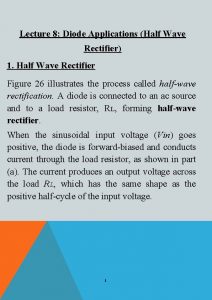Review Half Wave Full Wave Rectifier Center tapped













- Slides: 13

Review • Half Wave • Full Wave Rectifier • Center tapped • Bridge • Rectifier Parameters • PIV • Duty Cycle


Filters Ø A capacitor is added in parallel with the load resistor of a half-wave rectifier to form a simple filter circuit. At first there is no charge across the capacitor Ø During the 1 st quarter positive cycle, diode is forward biased, and C charges up. Ø VC = VO = VS - V. Ø As VS falls back towards zero, and into the negative cycle, the capacitor discharges through the resistor R. The diode is reversed biased ( turned off) Ø If the RC time constant is large, the voltage across the capacitor discharges exponentially.

Filters Ø During the next positive cycle of the input voltage, there is a point at which the input voltage is greater than the capacitor voltage, diode turns back on. Ø The diode remains on until the input reaches its peak value and the capacitor voltage is completely recharged.

Vp Vm Quarter cycle; capacitor charges up Capacitor discharges through R since diode becomes off VC = Vme – t / RC Input voltage is greater than the capacitor voltage; recharge before discharging again NOTE: Vm is the peak value of the capacitor voltage = VP - V Since the capacitor filters out a large portion of the sinusoidal signal, it is called a filter capacitor.

Ripple Voltage, and Diode Current ØVr = ripple voltage Tp ØVr = VM – VMe -T’/RC T’ where T’ = time of the capacitor to discharge to its lowest value Vr = VM ( 1 – e -T’/RC ) Expand the exponential in series, Vr = ( VMT’) / RC Figure: Half-wave rectifier with smoothing capacitor.

• If the ripple is very small, we can approximate T’ = Tp which is the period of the input signal • Hence for half wave rectifier Vr = ( VMTp) / RC l For full wave rectifier Vr = ( VM 0. 5 Tp) / RC

Example Consider a full wave center-tapped rectifier. The capacitor is connected in parallel to a resistor, R = 2. 5 k. The input voltage has a peak value of 120 V with a frequency of 60 Hz. The output voltage cannot be lower than 100 V. Assume the diode turn-on voltage, V = 0. 7 V. Calculate the value of the capacitor. VM = 120 – 0. 7 = 119. 3 V Vr = 119. 3 – 100 = 19. 3 V 19. 3 = 119. 3 / (2*60*2500*C) C = 20. 6 F

Example Consider a full wave bridge rectifier. The capacitor C = 20. 3 F is connected in parallel to a resistor, R = 10 k. The input voltage, vs = 50 sin (2 (60)t). Assume the diode turn-on voltage, V = 0. 7 V. Calculate the value of the ripple voltage. Frequency = 60 Hz VM = 50 – 1. 4 = 48. 6 V Vr = 48. 6 / (2*60*10 x 103*20. 3 x 10 -6) Vr = 2 V

The full-wave rectifier circuit is shown in the figure below. The output peak current of the circuit is 200 m. A when the peak output voltage is 12 V. Assume that input supply is 120 V(rms), 60 Hz and diode cut-in voltage Vγ = 0. 7 V. Find the required value of C for limiting the output ripple voltage, Vr = 0. 25 V. Answer: C = 6. 67 m. F

MULTIPLE DIODE CIRCUITS

Example 1 Cut-in voltage of each diode in the circuit shown in Figure is 0. 65 V. If the input voltage VI = 5 V, determine the value of R 1 when the value of ID 2 = 2 ID 1. Also find the values of Vo, ID 1 and ID 2. Assume that all diodes are forwardbiased.

Example 2 The figure shows a multiple diode circuit. If each diode cut-in voltage is Vγ= 0. 7 V, determine ID 1, ID 2 and VO for R 2 = 1. 1 k. Answers: ID 1 = 1 m. A ID 2 = 6 m. A VO = 2. 3 V
 Piv of full wave bridge rectifier
Piv of full wave bridge rectifier Half wave full wave rectifier
Half wave full wave rectifier Center tapped full wave rectifier with capacitor filter
Center tapped full wave rectifier with capacitor filter Full wave center tapped rectifier
Full wave center tapped rectifier Full wave rectifier center tapped
Full wave rectifier center tapped Difference between full wave and half wave rectifier
Difference between full wave and half wave rectifier Half wave rectifier battery charger
Half wave rectifier battery charger Formula of vrms in half wave rectifier
Formula of vrms in half wave rectifier Rl load example
Rl load example Half wave rectifier vrms
Half wave rectifier vrms Piv of diode
Piv of diode Atomic structure of a conductor
Atomic structure of a conductor Full wave rectifier
Full wave rectifier Full wave controlled bridge rectifier
Full wave controlled bridge rectifier


